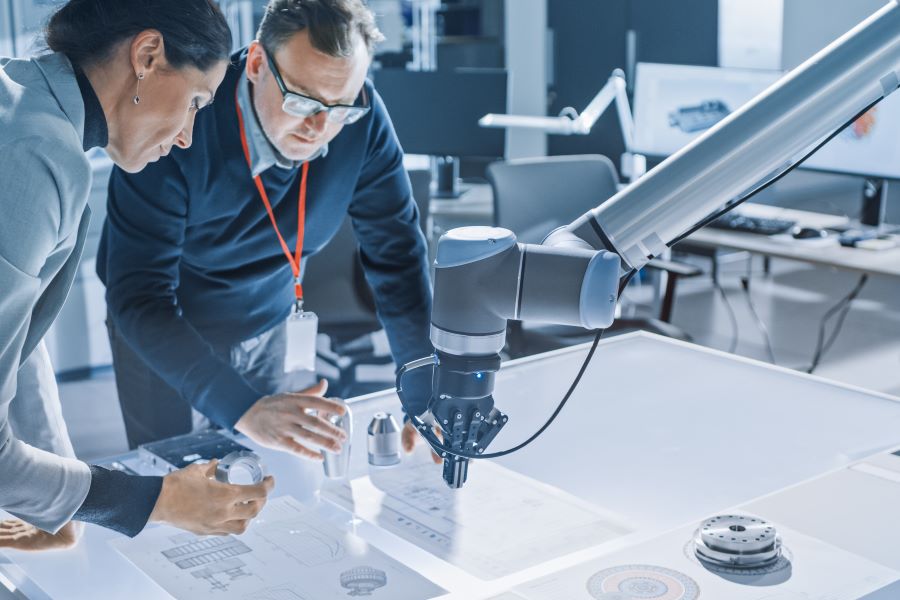A robotic arm is a type of technology often used by companies in the industrial field. It is one of the most common pieces of robotic machinery in factories, plants, and other industrial settings because of its exceptional display of speed and strength.
Using a robotic arm for your operations can also provide you with various benefits. First, your staff members can experience improved safety when working with a robotic arm. This is possible when they use the technology to work in hazardous environments and execute tasks that have a high risk of injury.
Another application for a robotic arm is to help you increase your production speed and efficiency. This is because the robotic arm has a faster operation than any human worker, resulting in shorter production times and higher yields. The robotic arm can also perform various tasks with minimal downtime as well as repeatability, meaning that it makes fewer errors than people.
But before you go out and invest in a robotic arm for your company, you should know that several robotic mechanisms can be called a robotic arm. Although they can be grouped under one term, most robotic arms have different characteristics that make them more suitable for certain applications than other types of robotic arms.
Types of Robotic Arms and Their Uses
Learning about the different types and functions of robotic arms is important if you want to make the most out of your investment. Doing so allows you to choose the right type of robotic arm for your company’s operations and know when to use the robotic arms properly.
Articulated Arm
The articulated arm is a general-purpose robotic arm that closely resembles a human arm. It is designed with at least five joints or degrees of freedom and mounted to a base that has a twisting joint.
Some of the typical applications for this robotic arm are assembly, material handling, and machine tending. Articulated arms are also used for machine tending and packaging because of their greater degree of motion.
Six-Axis
This is the most common type of articulated arm and is one of the most used robotic arms in the industry by companies all around the world. The six-axis robotic arm is designed with six joints, which can be configured for different applications.
This type of robotic arm is ideal for applications such as welding automation, material removal and handling, and painting. It is also highly reliable in terms of flexibility and reach when performing tasks because it can easily move in the x, y, and z planes.
Collaborative Robot
If you intend to use a robotic arm near humans, you should invest in collaborative robots or cobot solutions. This technology is built for hybrid work, which means that it has safety features that reduce the risk in the workplace.
Because collaborative robots are fairly new, the applications for these robotic arms are still being explored. However, as more companies are being exposed to this technology, they are discovering the benefits of this robotic arm.
SCARA
Selective Compliance Assembly/Articulated Robot Arm or SCARA is a 3-axis robotic arm. Because they are selectively compliant, SCARA robots are not as flexible as articulated arms although they can move in the x, y, and z axes and have a rotary motion.
SCARA robots are often used for assembly and palletizing tasks in industrial settings. Their speed and easy integration also allow them to excel in bio-med applications.
Cartesian
As the name implies, cartesian robots are designed to move in a linear direction and have three linear axes of movement (x, y, and z). These robotic arms are a popular choice among companies because of their highly flexible configurations, which allow you to adjust their speed, precision, stroke length, and size.
One of the main functions of this robotic arm is CNC machines. The cartesian robot can be used to program the machine’s origins, which greatly improves its accuracy and efficiency. It is also used in 3D printing because of its suitability for small applications.
Cylindrical
The cylindrical robot arm is equipped with a single arm that moves on a vertical member, which rotates the arm horizontally. This type of robotic arm is also compact, so it can fit in tight spaces and complete small and simple tasks.
Additionally, because of its design, the cylindrical robot arm can easily extend and retract to fulfill different tasks around the work site. Some of the main applications for this robotic arm include simple assembly, coating applications, and machine tending.
Parallel
Parallel robots, also called Delta, is the robotic arm you need to choose for high-speed applications. It has a unique design that allows it to achieve exceptional speed without compromising accuracy.
These types of robotic arms are most commonly used for fast pick and place tasks in the electronic, food, and pharmaceutical industries. They are also ideal for lightweight tasks around the workplace.
Do More With Robotic Arms
Robotic arms are a great investment because of their versatility and efficiency. With the right type of robotic arm, you can increase productivity while decreasing risks in the workplace.
Knowing when to use robotic arms will also make you more competitive in the industry. With this, you can make an informed decision on which type of robotic arm is best for your application.
Learn more about robotic arms and AI cobot solutions today by talking with our team!
Techman Robot’s AI cobots are equipped with advanced Al and machine learning capabilities that enables the cobots to increase their efficiency overtime. These cobots are known for their built-in smart vision system, providing ease of use and versatility, ideal for a wide range of applications, including material handling, AOI inspection, and palletizing.

